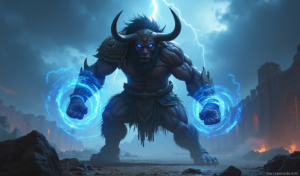Overview
Bard is a unique support champion in League of Legends who excels through a balance of lane presence and strategic roaming, utilizing his ability to collect chimes that power up his Meeps while creating opportunities with his distinctive toolkit of stuns, portals, and a game-changing ultimate. Mastering Bard requires understanding his wandering nature, developing strong map awareness, and practicing creative uses of his abilities, particularly Tempered Fate which can completely change teamfights or secure objectives when used correctly.
Table of Contents
- Introduction to Playing Bard
- Understanding Bard’s Unique Playstyle
- Mastering Meeps: Your Secret Weapon
- Magical Journey: Creative Pathing Strategies
- Cosmic Binding: Landing Stuns Consistently
- Tempered Fate: Game-Changing Ultimate Usage
- Roaming Techniques: Map Presence Optimization
- Item Builds and Rune Selection
- Conclusion
- Frequently Asked Questions
Introduction to Playing Bard
Learning how to play Bard effectively can transform your support game in League of Legends. As one of the most unique champions in the game, Bard offers an unparalleled blend of utility, mobility, and playmaking potential that rewards creative thinking and map awareness. However, mastering this cosmic wanderer requires dedication and a deep understanding of his distinctive kit.
Bard’s strength lies not in raw power but in his ability to create opportunities through clever positioning and timing. Unlike traditional supports who focus solely on lane presence, playing Bard effectively means embracing his roaming nature while still supporting your ADC when needed.
In this comprehensive guide, we’ll explore seven essential tips that will help you master Bard and elevate your support gameplay. From collecting chimes to landing game-changing ultimates, these strategies will help you harness the full potential of this extraordinary champion.
Understanding Bard’s Unique Playstyle
Before diving into specific techniques, it’s crucial to understand what makes Bard different from other supports. First and foremost, Bard is a roaming support who thrives on collecting chimes across the map. These magical artifacts not only provide experience and mana but also empower your Meeps, making them essential to your effectiveness.
Additionally, Bard excels at creating picks and opportunities through his stun (Cosmic Binding) and unique mobility tool (Magical Journey). His ultimate, Tempered Fate, can completely change teamfights or secure objectives when used correctly.
The key to playing Bard successfully is finding the perfect balance between lane presence and roaming. This requires excellent map awareness, timing, and communication with your ADC. Furthermore, you’ll need to make quick decisions about when to collect chimes, when to gank other lanes, and when to stay with your carry.
Understanding this fundamental playstyle is the foundation upon which all other Bard skills are built. Once you embrace his wandering nature and utility-focused kit, you’ll be ready to implement the specific strategies that will make you a formidable Bard player.
Bard thrives as a roaming support, similar to high-mobility playmakers like Alistar, who also excel at creating map pressure beyond the lane. Your success with Bard depends on balancing lane presence with efficient chime collection and timely roams.

Mastering Meeps: Your Secret Weapon
Bard’s passive, Traveler’s Call, provides him with Meeps – his adorable little companions that enhance his auto attacks. Learning how to maximize the value of these Meeps is essential for anyone looking to master how to play Bard effectively.
As you collect chimes throughout the map, your Meeps become increasingly powerful in several ways:
- They deal additional magic damage
- They apply a slow effect
- At higher chime counts, they can hit multiple targets
- The slow effect becomes stronger and lasts longer
Prioritizing chime collection during safe roaming opportunities is crucial. However, timing is everything – abandoning your ADC at inappropriate moments can be disastrous. Consequently, you should communicate your roaming intentions and collect chimes when your ADC is safely farming or backing.
In the early game, use your Meep-enhanced auto attacks to harass enemies and gain lane control. The slow effect makes it easier to land your Q (Cosmic Binding) for a potential stun. During teamfights, save your Meeps for key targets or use them to slow multiple enemies when your chime count is high enough.
Remember that Meeps recharge over time, and you can hold up to a certain number based on your chime count. Therefore, manage this resource carefully – don’t waste Meeps on minions unless you’re pushing a lane or need to quickly charge your support item.
As your Meeps evolve with chimes, their slow and multi-target damage echo the kind of scaling utility seen in mid laners like Anivia, whose control builds over time. Use this passive power to harass, zone, and set up stuns with Cosmic Binding.
Magical Journey: Creative Pathing Strategies
Bard’s E ability, Magical Journey, is one of the most unique mobility tools in League of Legends. This spell creates a one-way portal through terrain that both allies and enemies can use. Mastering creative pathing with Magical Journey is essential for anyone learning how to play Bard at a high level.
Use Magical Journey for quick escapes when caught in dangerous situations. Creating a portal through a thick wall can give you the distance needed to survive a gank or reposition in a teamfight. Remember that enemies can follow you through the portal, so be mindful of where it exits.
In addition to escapes, Magical Journey offers incredible gank opportunities. Coordinate with your jungler to create unexpected entrance angles that bypass standard ward spots. This surprise factor can lead to successful ganks even against cautious opponents who believe they have sufficient vision.
Some advanced Magical Journey techniques include:
- Creating shortcuts to objectives like Dragon or Baron
- Setting up ambushes by waiting at the exit point of a portal
- Using it to quickly return to lane after collecting chimes
- Helping immobile teammates reposition in teamfights
- Baiting enemies into following you into a waiting team
Practice using Magical Journey in Practice Tool to learn the range limitations and optimal portal placements across different map locations. Furthermore, remember that portal placement is determined by your cursor position relative to the wall – practice this to ensure you create portals that go exactly where you want them to.
Cosmic Binding: Landing Stuns Consistently
Cosmic Binding (Q) is Bard’s primary crowd control ability and mastering it is crucial for anyone looking to excel at how to play Bard. This skillshot fires a bolt of energy that slows the first enemy hit and continues traveling. If it hits another enemy or terrain, both targets become stunned.
The key to landing consistent stuns with Cosmic Binding is understanding its interaction with terrain and positioning. Look for opportunities where enemies are near walls, structures, or other units. In lane, try to position yourself so that when an enemy approaches a minion, you can stun them through it.
Practice predicting enemy movement patterns to increase your accuracy. Watch how opponents tend to dodge and aim accordingly. Additionally, use your Meep auto attacks to slow enemies first, making it easier to land your Q afterward.
Some advanced Cosmic Binding techniques include:
- Stunning enemies through their own minions
- Using your ultimate to set up guaranteed stuns
- Firing through narrow jungle corridors where dodging is difficult
- Stunning enemies through monsters at jungle entrances
Remember that Cosmic Binding is your primary defensive tool as well. Save it when you expect enemy engage attempts, especially against champions with gap closers. Having this ability available can be the difference between surviving a gank and giving up a kill.
According to professional player builds, maxing Cosmic Binding first is generally the optimal choice, as it reduces cooldown and increases damage and stun duration.

Tempered Fate: Game-Changing Ultimate Usage
Tempered Fate, Bard’s ultimate ability, is perhaps one of the most versatile and impactful ultimates in League of Legends. This ability launches a cosmic sphere that puts all units it hits – allies, enemies, monsters, and structures – in stasis for 2.5 seconds. Learning when and how to use this powerful tool is critical for anyone serious about how to play Bard effectively.
First and foremost, use Tempered Fate to set up team engages. Landing it on multiple enemy champions creates a perfect opportunity for your team to position before they become active again. Consequently, this can lead to devastating follow-up CC chains and burst damage.
Beyond team engages, Tempered Fate has numerous strategic applications:
- Freezing objectives like Dragon or Baron to prevent the enemy team from securing them
- Saving allies from certain death by putting them in stasis
- Neutralizing enemy carries during crucial moments in teamfights
- Disabling enemy turrets for tower dives
- Preventing enemy escapes by landing it in their path
Be cautious when using Tempered Fate, as poor timing can inadvertently save enemies or disrupt your team’s abilities. Communication is key – alert your team before using this ultimate so they can prepare to capitalize on it.
According to professional play statistics, the most effective Bard players use Tempered Fate an average of 8-10 times per game, suggesting quality over quantity in ultimate usage.
Roaming Techniques: Map Presence Optimization
Effective roaming is the cornerstone of Bard’s playstyle, separating good Bard players from great ones. When learning how to play Bard, developing strong roaming habits and timing is essential to maximize your impact across the map.
Start by identifying optimal roaming windows during the laning phase. These typically occur when your ADC is safely farming under tower, after pushing the wave, or when they’ve backed to shop. Before leaving lane, communicate your intentions to prevent your carry from engaging unexpectedly.
When roaming, prioritize routes that allow you to collect chimes while moving toward an objective or gank opportunity. This efficiency ensures you’re constantly scaling through your passive while making map-wide impact. Additionally, use Control Wards and Sweeping Lens to clear vision along your roaming paths.
Effective roaming destinations include:
- Mid lane for 3v2 ganks with your jungler
- Enemy jungle for deep vision or catching the jungler off guard
- River to secure Scuttle Crab control or assist in skirmishes
- Objectives like Dragon or Herald when they’re spawning
Use your Magical Journey to create unexpected gank angles that bypass standard ward locations. Furthermore, coordinate with your jungler to create powerful 3-person ganks or invades that can lead to kills and objective control.
Remember that successful roaming isn’t measured solely by kills. Applying pressure, forcing summoner spells, or simply creating a presence that makes enemies play more cautiously can be valuable outcomes of your wanderings.
Item Builds and Rune Selection
Optimizing your item builds and rune selections is crucial for anyone learning how to play Bard effectively. The right choices complement Bard’s unique playstyle and enhance his utility, survival, and playmaking potential.
For runes, Guardian is often the safest primary choice, providing extra survivability for both you and allies you protect. Alternatively, players who prefer a more aggressive approach might opt for Electrocute or even Hail of Blades to enhance Bard’s trading potential. Secondary runes should typically focus on mobility and utility with options like Celerity, Waterwalking, or Cosmic Insight.
Core item builds for Bard usually start with a support item, typically Spellthief’s Edge for its gold generation and offensive stats. From there, prioritize these key items:
- Mobility Boots – Essential for effective roaming and chime collection
- Dead Man’s Plate – Provides armor and additional movement speed
- Rapid Firecannon – Extends auto attack range for safer Meep applications
- Locket of the Iron Solari – Team-wide shield for protection in teamfights
- Redemption – Healing and utility that can turn teamfights
Adapt your build based on the game situation. Against heavy AD threats, consider Frozen Heart or Randuin’s Omen. For AP-heavy enemy teams, Abyssal Mask or Force of Nature can be valuable. If your team needs additional engage tools, consider items like Shurelya’s Battlesong.
Don’t underestimate the value of Control Wards throughout the game. As a roaming support, having strong vision control enables your playmaking and keeps your teammates safe from ganks. Always carry at least one Control Ward and refresh it whenever possible.
Adapting your itemization based on team needs is a key trait of smart support play. Just as Annie players flex between damage and utility builds, Bard can alternate between engage tools and defensive auras depending on game state.
Conclusion
Mastering how to play Bard requires patience, practice, and a willingness to think outside the conventional support role. His unique kit offers unparalleled utility and playmaking potential that rewards creative thinking and excellent map awareness.
By focusing on these seven essential tips – understanding his playstyle, mastering Meeps, creating creative paths with Magical Journey, landing consistent stuns, using Tempered Fate effectively, optimizing your roaming, and selecting appropriate builds – you’ll be well on your way to becoming a formidable Bard player.
Remember that Bard’s greatest strength lies in his versatility and adaptability. No two games will play out exactly the same way, so be prepared to adjust your strategy based on team compositions and game state. Furthermore, communication with your team is crucial, especially when roaming or using your ultimate.
As you continue to practice how to play Bard, you’ll develop an intuitive sense for timing and opportunity that will make you a valued asset to any team. So collect those chimes, create magical journeys, and change the fate of your games with this extraordinary champion!
Frequently Asked Questions
When should I roam as Bard?
Roam when your ADC is safely farming under tower, after pushing a wave, or when they’ve backed to shop. The best times to collect chimes are when you’re moving between lanes or heading to objectives. Always communicate your roaming intentions to your ADC, and try to time your returns to lane so your carry isn’t left vulnerable for too long. Early game roams should typically be quick and purposeful rather than extended journeys.
How many chimes should I aim to collect in a typical game?
In a standard 30-35 minute game, aim for at least 60-80 chimes. Professional Bard players often average 2-3 chimes per minute in the early game, slowing down slightly in the mid to late game. Don’t risk dying for chimes – they’re important but not worth sacrificing your life or leaving your team in a 4v5 situation during critical moments. Remember that chimes spawn in somewhat predictable patterns, with more appearing in enemy territory.
What makes Bard’s ultimate so difficult to use?
Tempered Fate’s difficulty stems from its potential to both help and harm your team. Its long range and travel time make it hard to land precisely, and it affects allies and enemies equally. Poor timing can save enemies from damage, interrupt your team’s abilities, or prevent crucial plays. Success with this ultimate requires practice, anticipation of enemy movements, and clear team communication. Start with simple applications like tower dives or objective steals before attempting more complex plays.
Which ADC champions synergize best with Bard?
Bard works best with self-sufficient ADCs who can farm safely during your roams. Champions like Ezreal, Tristana, and Caitlyn have mobility or range that helps them stay safe. Jhin synergizes well with Bard’s stun for follow-up root chains. Avoid pairing Bard with scaling hypercarries who need constant protection like Kog’Maw or immobile ADCs like Jinx unless you’re very experienced with Bard. The ideal lane partner understands Bard’s roaming nature and won’t overextend while you’re collecting chimes.
Is Bard good for beginners or should I learn other supports first?
Bard has a steep learning curve and isn’t ideal for beginners to the support role. His unique playstyle requires excellent map awareness, timing, and decision-making that can be overwhelming for new players. Consider mastering more straightforward supports like Leona, Nautilus, or Nami first to understand support fundamentals. Once you’re comfortable with warding, roaming, and protecting your carry, Bard becomes a rewarding choice that can elevate your support gameplay. Most players need at least 15-20 games to start feeling comfortable with Bard’s mechanics.




